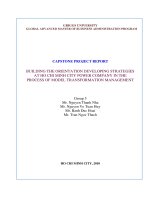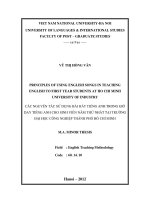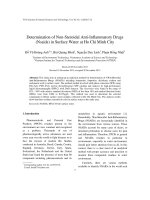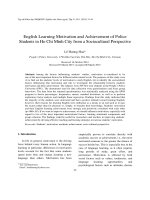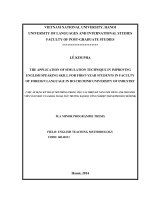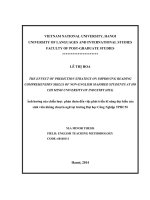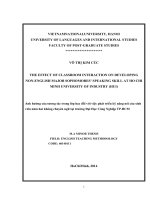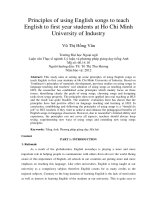THE EFFECT OF PREDICTION STRATEGY ON IMPROVING READING COMPREHENSION SKILLS OF NON-ENGLISH MAJORED STUDENTS AT HO CHI MINH UNIVERSITY OF INDUSTRY (HUI
Bạn đang xem bản rút gọn của tài liệu. Xem và tải ngay bản đầy đủ của tài liệu tại đây (816.53 KB, 44 trang )
VIETNAM NATIONAL UNIVERSITY, HANOI
UNIVERSITY OF LANGUAGES AND INTERNATIONAL STUDIES
FACULTY OF POST-GRADUATE STUDIES
*********************
LÊ THỊ HOA
THE EFFECT OF PREDICTION STRATEGY ON IMPROVING READING
COMPREHENSION SKILLS OF NON-ENGLISH MAJORED STUDENTS AT HO
CHI MINH UNIVERSITY OF INDUSTRY (HUI)
Ảnh hưởng của chiến lược phán đoán đến việc phát triển kĩ năng đọc hiểu của
sinh viên không chuyên ngữ tại trường Đại học Công Nghiệp TPHCM
M.A MINOR THESIS
FIELD: ENGLISH TEACHING METHODOLOGY
CODE: 60140111
Hanoi, 2014
VIETNAM NATIONAL UNIVERSITY, HANOI
UNIVERSITY OF LANGUAGES AND INTERNATIONAL STUDIES
FACULTY OF POST-GRADUATE STUDIES
*********************
LÊ THỊ HOA
THE EFFECT OF PREDICTION STRATEGY ON IMPROVING READING
COMPREHENSION SKILLS OF NON-ENGLISH MAJORED STUDENTS AT HO
CHI MINH UNIVERSITY OF INDUSTRY (HUI)
Ảnh hưởng của chiến lược phán đoán đến việc phát triển kĩ năng đọc hiểu của
sinh viên không chuyên ngữ tại trường Đại học Công Nghiệp TPHCM.
M.A MINOR THESIS
FIELD: ENGLISH TEACHING METHODOLOGY
CODE: 60140111
SUPERVISOR: PHẠM HỮU ĐỨC, PhD.
Hanoi, 2014
DECLARATION OF AUTHORSHIP
I, LÊ THỊ HOA, declare that this graduation thesis is original and has not been
submitted for assessment elsewhere.
I declare that this assignment is my own work and does not involve plagiarism or
collusion.
Date: … / … / 2014
Signature
LÊ THỊ HOA
ACKNOWLEDGEMENTS
I would like to express my thanks to many people who have assisted my research
work.
Firstly, my great appreciations go to the contribution of my supervisor Pham
Huu Duc, Ph.D who spent time and energy helping me complete my thesis. I am
grateful to his valuable guidance and great insight into my thesis writing. His guidance
was indispensable to the design and completion of the study. I am also grateful to him
for his comments, correction and for her kindly encouragement and enthusiasm during
the development of this study.
Secondly, my special words are also extended to my students. They were very
enthusiastic when studying with my instruction; they encouragedme in being confident
to accomplish my practice completely. Their support is greatly appreciated.
Next, I would like to thank my family for supporting me, taking care of me and
encouraging me during the time I implemented the thesis. Their love and expectation
for me is a great encouragement to complete the thesis. Finally, I also want to give
acknowledgement to my friends who spent their time to help me during the process,
gave me insightful comments for my thesis, and encouraged me when I was
demotivated during this hard and stressful time.
ABSTRACT
This study aims to emphasize the effect of prediction strategy in reading
comprehension with the application of some techniques for pre-reading and while-
reading activities to check the effect of prediction strategy after the lessons. The
participants were 52 English non-majored students who participated in the complete
learning course. This was indicated by students’ responses during the teaching and
learning process. It was also strengthened by the data from the questionnaires after
Cycle 2 in which the students pointed out that they enjoyed and interested in doing the
reading activities using the prediction activities. The important thing for teachers is that
they need to consider the effective techniques used in improving prediction strategy in
particular and reading skill in general in order to meet the need of the students and
motivate them in learning reading comprehension skill.
TABLE OF CONTENTS
DECLARATION OF AUTHORSHIP i
ACKNOWLEGDEMENT ii
ABSTRACT iii
TABLES OF CONTENTS iv
DEFINITION OF TERMS v
LIST OF TABLES AND FIGURES vi
Part A: INTRODUCTION
1. Rationale 1
2. Aims of the Study 1
3. Research questions 2
4. Scope of the study 2
5. Importance of the study 2
6. Method of the Study 3
7. Design of the Study 3
Part B: DEVELOPMENT
CHAPTER 1: LITERATURE REVIEW 5
1.1. Reading skill 5
1.1.1. Definitions of reading 5
1.1.2. The importance of reading 5
1.1.3. Reading comprehension 9
1.2. Prediction strategy 11
1.2.1. Definitions of prediction strategy… ……………………12
1.2.2. Importance of prediction strategy ……………………………13
CHAPTER 2: METHODOLOGY 15
2.1. Participants and settings of the study 15
2.2. Data collection……………… 15
2.2.1. Data collection instrument……………………………………… 15
2.2.2. Data collection procedure 15
2.2.3. Data analysis procedure 17
CHAPTER 3: FINDINGS AND DISCUSSION……… 19
3.1. Findings ………………………………………… 19
3.1.1. Analysis from the reading tests 19
3.1.2. Response to questionnaire… 22
3.2. Discussion……………………………… 24
3.2.1. Having authentic reading purpose…………………………………….….24
3.2.2. Choosing authentic reading materials………………………… ……… 25
3.2.3. Improving background knowledge for further reading……………… 26
3.2.4. Improving vocabulary by reading as much as possible………………… 27
3.2.5. Combining prediction strategy with other strategies………… …………28.
3.3. Pedagogical Implication 29
PART C: CONCLUSION
1. Conclusion of the study………………… …… ………….………… …30
2. Limitation of the study………………………… .………….… 31
3. Suggestions for Further Research…………… …….… … ……32
REFERENCES 33
APPENDIXES I
PART A: INTRODUCTION
1. Rationale
These days, there is no doubt that the English language is becoming something
of a forerunner in the global communication. It is the language of choice in most
countries of the world. It brings people together, gets out of the border of a country and
brings the world closer. As an effective means of international communication, English
is used as the official language in many fields of life such as economics, politics,
science, technology, sports and many others. This leads to an increasing demand of
learning English. In many Asian countries such as Singapore, Philippine, Malaysia or
Thailand, English is used as an official language besides their mother language; and
Vietnam is not an exception. ―English is now commonly used in exchange between,
say, Japanese and Argentinean business people, or between Singaporeans and their
Vietnam counterparts‖, noted Harmer (2007, p.13). In our country, more and more
people consider mastering English skills as an important factor to improve their work,
get higher position in their companies. Thus, English is playing a very significant role
in bringing the world together. In the world integration, English is really an essential
tool for the country development. Universities and colleges in Vietnam including Ho
Chi Minh city University of Industry (HUI) have tried their best to improve their
students’ English quality to meet the demand of the country development. However,
learning another language is not easy at all. With four macro skills including listening,
speaking, reading and writing, listening and speaking is most used in communication,
even in daily life. However, reading skill is also essential for us in order to update our
knowledge because we have to use reading skill in reading newspaper, reading books
or documents related to our profession. With strengthened reading skill, EFL readers
will make a greater progress and greater development not only in English but also in
other academic fields. Therefore, ―Reading skill need to be fostered so that learners
can cope with more and more sophisticated texts and tasks, and deal with them
efficiently: quickly, appropriately and skillfully‖, wrote Ur (1996, p.147).
2. Aims of the research
The research aims:
- To investigate the effects of prediction strategy on the students’ reading ability;
- To provide the teachers with some suggestions to make best use of prediction
strategy in teaching and learning reading comprehension.
3. Research Question
Based on the aims of the research, the author will attempt to answer the following
questions:
- What is the initial reading ability of the students?
- Does prediction strategy affect students’ reading ability?
- What can be done to improve prediction strategy?
4. Scope of the study
I have taught English to non-majored students at HUI for more than one year.
Most of them have difficulties in learning English macro skills. Besides listening,
writing and speaking, during the process of teaching English to non-majored English
students, I found out that they really have problems in reading. In other words, they do
not have right strategies for learning reading. To each reading passage, they try to
understand every word, stop and look up the dictionary whenever they reach the
unfamiliar words. Most students start reading immediately after they receive the text
without trying to look at the title to think about the text’s topic before reading or trying
to use their background knowledge to facilitate their comprehension. This always takes
time and does not have good results.“The dictionary is often over-used, resulting in
slower, less fluent reading, as well as frequently misunderstanding through selection of
the wrong definition‖, noted Ur (1996, p.149). Word-by-word translation sometimes
makes them misunderstand the meaning of the whole text. Therefore, the final result of
reading is not good.
5. Importance of the study
According to Richard and Renandya (2002, p.273), good reading texts also
provide good models for writing, and also provide opportunities to introduce new
topics, to stimulate discussion and to study language. It can be said that learning
Reading is the challenging part in both teaching and learning languages. The findings
of the study will be useful for improving students’ reading comprehension with
prediction strategy. It is believed to be beneficial to both teachers and learners.
6. Methods of the Study
In order to reach the aims of the study mentioned above, the study includes
tests and survey questionnaires to collect data on the reading strategies employed by
HUI English non-majored students. First, the three reading comprehension tests were
given to the subjects in order to identify their reading proficiency levels. The first test
was to estimate their initial reading levels; the two last was to evaluate the effect of
prediction strategy on their reading comprehension skills. Then, the questionnaires
were administered to find out their reading strategies.
After the data is analyzed and discussed, some conclusion will be drawn, and
some suggestion will be raised in the thesis.
7. Design of the Study
The thesis consists of three main parts: INTRODUCTION which provides an
overview of the study, DEVELOPMENT which is the main part and consists of 3
chapters, and CONCLUSION which includes the summary, pedagogical implications,
limitations of the study and suggestions for further study.
Three chapters in the main part are as follows:
Chapter 1: Literature Review is the review of the literature related to the research
topic, which serves as a theoretical foundation of the study.
Chapter 2: Methodology provides information about the research context, participants,
research approach, data collection instruments, data collection procedures, and data
analysis procedures.
Chapter 3: Findings and Discussion is the main part of the study, which reports and
discusses the main findings according to the research questions.
PART B: DEVELOPMENT
CHAPTER I: LITERATURE REVIEW
1. Reading Skill
1.1 . Definition of reading
The written word surrounds us daily. It confuses us and enlightens us, depresses
us and amuses us, sickens us and heals us (Brown, 1994, p.283). It is the reason why
reading is very important to us, even in daily life to update our knowledge. However,
learning it is not easy, and using adequate method in learning and teaching this skill is
a challenge to both teachers and students. Many students have difficulties in reading
skill because of different reasons. Therefore, there are many research studies on
challenges, key principles or strategies for reading skill. The question of how can
learners be good at reading skill in foreign language is in concern of many linguistics
in order to help students with difficulties in reading skill. Many linguists all over the
world have paid attention on studying how to teach and learn English reading skill
effectively, and which difficulties learners often have when reading in a foreign
language. Rand Reading Study Group (2002, p.4) in their research also mentioned
three factors that cause difficulties for students to understand reading text, noting that
the features of the text have a large effect on comprehension. It can be said that if the
reading text is not suitable for students’ level, understanding fails. They also pointed
out that the text can be easy or difficult, depending on factors inherent in the text, on
the relationship between the text and the knowledge and abilities of the reader, and on
the activities in which the reader is engaged. Rand Reading Study Group, in their
research, studied difficulties related to the text that challenges students to understand
the text such as the vocabulary load in the text and its linguistic structure, discourse
style and genre. Rand Reading Study Group (2002, p.5) concluded that if too many of
these factors do not match a reader’s knowledge and experience, the text might be too
difficult for optimal comprehension to occur. This means that the text and readers’
knowledge and experience interact with each other; if the reader has no knowledge or
experience about what they are reading, they cannot reach the author’s ideas in the text.
Besides, Strong et al (2002) in their research on Reading for Academic Success
also showed the reasons why the textbooks cause difficulties for students to read. In
their opinion, there are four reasons for that. These are text structure, information
overload, the ―authority‖ of the textbook and new vocabulary and concepts that are
disconnected from experience and prior knowledge. Strong et al (2002, p.2)noted that
trying to differentiate the important information from the not-so-important information,
attempting to make sense of tables and diagrams that were sandwiched into text,
keeping track of all the new vocabulary words, doing their best thwart boredom and
lagging attention pans-these are the associations. Sharing the same view with Strong
and his friends, Ur (1996, p.146) in his book also gave a suggestion that the text should
be accessible: if learners cannot understand vital information without looking up words
or being given extra information from elsewhere.
In addition to the text, background knowledge also plays an important role in
reading process. Many students have difficulties in reading because they have no idea
about what they are reading. For this issue, Patricia L Carrel from Southern Illinois
University at Carbondale carried out a research on some issues in studying the role of
background knowledge in Second Language Comprehension which was presented at
the TESOL Convention in Toronto. She found out the effect of background knowledge
in reading on both in native language comprehension and second or foreign language
comprehension. She indicated that ―English as a foreign or second language which
shows the joint or interactive effects of content and formal background information in
comprehension‖ (Carrel, 1983, p. 88). In the same view with Carrel, Nunan(1999,
p.257) also mentioned to the challenge with background knowledge, ―Reading
comprehension is thus an interactive process between the reader and the text, in that
reader is required to fit the clues provided in the text to his or her own background
knowledge. To be skilled in reading depends on the efficient interaction between
linguistic knowledge and knowledge of the world (Nunan, 1994, p. 284).
The term of ―Reading‖ is widely used in practice. However, reading is
differently defined due to the areas of defining in term of activities or goals at any one
level on grade. That is why no definition of reading can possibly include all points of
views and features.
However, a careful considered definition of reading is very necessary for the
reading teacher. Because reading is the most critical aspect of any teaching program
and for the teachers to decide what they will teach in the classroom, herein, I would
like to mention some definitions of reading extracted from different sources on the
theme. Elias and Ingram (1977, p.55) stated that Reading was defined as the
abstraction of meaning from a visual configuration, and was shown to involve
desirably not a painstaking grapheme- by- grapheme decoding but the postulation of
alternatives of meaning which one reduced by the parsimonious interaction of the
component process with the visual configuration. Besides, Moses A. Adeniji and Anne
Omaley(1997) gave definition of reading that reading is the recognition of printed or
written symbols, which serve as stimuli for the recall of meanings built up through the
reader's past experience. It has also been described as a process of translating
alphabetical symbols into a form of language from which the native speaker has
already derived the meaning. Especially, Buzan in his book – The Speed Reading
(1997) finds that all common reading definitions only relate to a part of the process and
an accurate definition of reading must contain the full range of reading skills, or
reading as a multi- level process, which comprise the following steps:
Recognition: You are concerned with understanding of alphabetical
symbols. This step occurs instantly before physical reading begins.
Assimilation: This step starts with word then to the eye and via the
optic nerve to the brain.
Intra- Integration: This step refers to the link of all parts of the
information being read with all other appropriate parts.
Extra- Integration: This step requires learners to bring all of their
previous knowledge to what they read, making appropriate connections,
analyzing, criticizing, appreciating, selecting and rejecting.
Retention: This step requires the basic storage of information of the
readers.
Recall: This process shows the ability of the readers to get back the
storage when it is needed.
Communication: This process includes written and spoken in which
information is used immediately or eventually. It also contains very crucial and
often neglected human function: Thinking- thinking is your ongoing extra
integration (Buzan, 1997, p.34).
Although those reading definitions are of different attitudes to reading, they
seem to have some features in common. It is because they all concentrate on the nature
of reading. To make this point clear, Abbot, Wingard, Greenwood and
McKeating(1981: 81) showed that. Here are two broad aspects or levels. First there is
basically visual task, that of deciphering the marks on the page, the brain receiving
signals, from the eyes. Secondly, there is cognitive task, that of interpreting the visual
information, so the one is not simply ―barking at print‖. Hunt (2004: 137) also
expressed that reading is a process shaped partly by the text, partly by the readers’
background, and partly by the situation the reading occurs in. Deriving from those
opinions, reading is considered as a process in which a reader looks at and understands
what has been written out.
1.2 Importance of reading
According to Rubin (1987), cited in Schmitt (1997, p.203), learning strategies are
defined as ―the process by which information is obtained, stored, retrieved, and used‖
and ―therefore vocabulary learning strategies could be any which affect this broadly-
defined process‖.
To Carrel (1984, p.1), for many students, reading is by far the most important of
the four macro-skills, particularly in English as a second language. This is also true to
the students at FFL at HUI since the reading skill offers them a wide range of
interesting information as well as a variety of language expressions and structures that
are of great usefulness for developing other language skills. For example, if you read a
lot, you will have a large of number of vocabulary. It is very useful when you learn
writing; or if we want to express something but not want to repeat the former word you
easily to find another word to replace. Vocabulary is also a great help to your speaking
skill. Moreover, when reading we discover new things about what you have never
known before. Besides widening reader’s knowledge about things outside world and
the realistic society, it is also the best way to develop mind. The mind is a muscle. It
needs exercise. Knowing and understanding the written word is one way the mind
grows in its ability. Reading lots, having knowledge from that also builds self-
confident because. The more you read, the more knowledgeable you become and with
more knowledge come more confidence. More confidence builds self-esteem.
Generally, no one can deny that reading brings readers an ocean of knowledge of
different areas. They can learn more experience of life. Then they have necessary
benefits to avoid difficulties in mutual understanding in communication such as culture
shock, language shock due to different cultures, habits, and languages. Moreover,
reading is also an important way of expanding students’ receptive knowledge of
language and stimulating students to talk and write.
Deriving from some of reading definitions above, we find that reading is a very
important factor in language acquisition. It is important because it is considered an
essential skill both at school and afterwards. Reading takes its place alongside the
development of oral ability in the school program. Reading also gives us as readers
many opportunities to contact with different contexts in our daily life. Byrne (1988,
p.46) provides three reasons for the importance of reading as follows.
a) It offers language learners another area of success. We should accept that not
all students would be good speakers and at least give them credit if they become good
readers
b) It gives the students a skill that they can use on their own (i.e. it is a key to
self- access work)
c) It is likely to be one of the skills that most students will need in the long term.
It is one that they will always be able to put to use. That is, they can read even if they
do not get any opportunities to speak.
Generally, no one can deny that reading brings readers an ocean of knowledge
of different areas. They can learn more experience of life. Then they have necessary
benefits to avoid difficulties in mutual understanding in communication such as culture
shock, language shock due to different cultures, habits, and languages. Moreover,
reading is also an important way of expanding students’ receptive knowledge of
language and stimulating students to talk and write.
However, all reasons mentioned earlier show that in terms of classroom
activities it is good for students to read but we cannot assume that all students are
efficient readers. Much depends on how well they have been taught to read in their
mother tongue.
1.3 . Reading comprehension
Richard and Renandya (2002, p. 277) noted that ―Reading for comprehension is
the primary purpose for reading and that raising students’ awareness of main ideas in a
text and exploring the organization of a text are essential for good comprehension‖.
In teaching reading, it is necessary to understand the nature of reading
comprehension. What the teacher understands about it will have a great influence on
what he or she teaches in the class. He would know what to teach and how to make his
reading lesson effectively. In fact, methodologists have been providing different
definitions of reading comprehension.
According to Grelet (1981, p. 3), ―Reading comprehension or understanding a
written text means extracting the required information from it as efficiently as
possible‖. He means that reading comprehension is an activity that aims at decoding
the meaning of word combination in the text in the most efficient way.
Also concerning the reading comprehension, Richard (1978) provided a clearer
point of view:
Reading comprehension is best described as an understanding between
the author and the reader. The emphasis is on the reader understanding of
the printed page based on the individual reader’s unique background of
experience. Reading is much than just pronouncing words correctly or
simply what the author intends. It is the process whereby the printed
pages stimulate ideas, experiences and responses that are unique to an
individual.
According to Richard (1978), reading comprehension ―is not only
understanding simply what is written, but also is what stimulates students to remember
from their experiences‖. This means that that knowledge is then used to get meaning
out of printed page, but the mind of the readers includes not only facts and details but
also emotion, belief and critical evaluation.
From these opinions, it can be concluded that reading comprehension is a
process of understanding what is conveyed in the text. It does not mean that the reader
needs to understand every single word in the text but actively work on the text and
extract the required information efficiently.
Reading model: top-down; bottom-up; interaction
2. Prediction strategy
2.1 Definition
What is prediction? According to Collin (1982), ―prediction is an integral part of
competent readers' metacognitive strategies, which are used to monitor comprehension
as the text is read‖. Effective readers wisely use pictures, titles, headings, and text - as
well as personal experiences—to make predictions before they begin to read. Making
predictions is a strategy in which readers use information from a text (including titles,
headings, pictures, and diagrams) and their own personal experiences to anticipate
what they are about to read (or what comes next). A reader involved in making
predictions is focused on the text at hand, constantly thinking ahead and also refining,
revising, and verifying his or her predictions. This strategy also helps students make
connections between their prior knowledge and the text. Predicting involves thinking
ahead while reading and anticipating information and events in the text. After making
predictions, students can read through the text and refine, revise, and verify their
predictions. The strategy of making predictions actively engages students and connects
them to the text by asking them what they think might occur in the story. Using the
text, students refine, revise, and verify their thinking and predictions
()
2.2 Importance of prediction strategy
Making predictions is more than just guessing what is going to happen next.
Predicting helps students become actively involved in reading and helps to keep their
interest level high. Making predictions activates students' prior knowledge about the
text and helps them make connections between what is new and what they already
know. By making predictions about the text before, during, and after reading, students
use what they already know – as well as what they suppose might happen – to make
connections to the text.
Snow (1998) has found that throughout the early grades, reading curricula
should include explicit instruction on strategies used to comprehend text either read to
the students or let students read themselves. These strategies include summarizing the
main idea, predicting events or information to which the text is leading, drawing
inferences, and monitoring for misunderstandings.
Normally, when having reading comprehension, good readers frequently make
predictions about what is to come. Douglas (1994: 295) showed that one way for
learners to make guessing pay off when they don’t immediately recognize a word is to
analyze it in terms of what they know about it. Making prediction is a strategy in which
readers make use of the information from the text and their prior knowledge to
generalize about what they are going to read about. He also concluded thata better
strategy is to use the context, the words and sentences surrounding a particular word, to
help you guess that word’s meaning. These guesses will be accurate enough for readers
to understand the author’s ideas.
As for language learning strategies about what every teacher should know, it is
said that prediction is one of the most effective factors that motivates students to read
and understand the meaning of the context. In order to make a prediction, readers need
to explain what they believe will happen in the text before reading. Predictions can be
done at the beginning of the text or throughout reading. Predicting allows us to think
ahead before we begin reading. Prediction gets us thinking about the ideas that may
occur throughout the text, and create our own. In doing this, it makes readers become
more engaged in the text. Good readers know how to use their background knowledge
and experiences to help them understand what they are hearing or reading.
CHAPTER 2: METHODOLOGY
2.1. Participants and setting of the study
The study was conducted with the participation of 52 students in an English
non-majored class at HUI. Most of the students are freshmen and they are learning with
a basic level. They were going to study in 5 lessons of reading comprehension with
prediction strategy.
2.2. Data collection
2.2.1. Data collection instrument
The data was collected via a number of instruments including three different
tests: a pre-test for preliminary investigation into the students’ reading levels and two
post-tests to measure the impact of predicting strategy instruction on the students'
reading comprehension , and a questionnaire after the three tests.
2.2.2. Data collection procedure
In terms of research approach, an action research was employed as this study
was conducted to examine the impact of a small scale of intervention, predicting
strategy instruction, on the reading comprehension of 52 students and determine
effective techniques to teach these students predicting strategies to improve their
reading comprehension. The intervention, a predicting strategy instruction course
includes three lessons on predicting the content of the text from the title, the picture,
the first sentence of a paragraph, and the prior knowledge of the content and textual
structure. Here are some techniques of prediction strategy in reading comprehension
applied in the course.
Table 1: activities for pre-reading and while-reading
BEFORE READING
WHILE READING
Activating background knowledge
· Open prediction
· True/ False prediction
· Pre-question
· Network
· If You Don’t Know, Ask, OK?
Previewing
· Look at the title and the headings for each
section to predict what the reading text is
about.
· Look at the pictures to predict what the
reading text is about.
Overviewing
· Read the first and the last paragraphs each
paragraph to predict what it is about.
Reading and Confirming Prior
Predictions
· Read and confirm or reject the prior
predictions
Predicting What to Come Next
· Use the prior knowledge about the topic
to
predict what to come next in the passage
· Use the prior knowledge about the
textual structure of the text to predict what
to come next.
At the beginning of the course, the students will take part in a pre-test to
emphasize their level of reading comprehension. After two first lessons with prediction
strategy, a test was delivered and the last test was taken place after the next two
lessons.
At the end of the course, a questionnaire of five questions was delivered to
students to find out their reading strategy before taking the course and their opinion for
the good technique in improving prediction strategy.
2.2.3. Data analysis procedure
In order to achieve the aims of the study mentioned above, the quantitative
analysis the main tool for analyzing the data, which is collected from the questionnaire
and it was conducted by using Excel technique. Together with analyzing questionnaire,
the three tests were analyzed with Excel tool.
This classroom action research is carried out within three stages. In the first
stage, the researcher planed lesson plans with strategies and activities for improving the
students’ prediction strategy as well as the materials and how to present the materials
effectively. From the second stage, the researcher will be applied what she prepared in
the first stage to teach the students in the class. The last stage is reflection. In this stage,
the researcher reflected the result of effectiveness of applying prediction strategy in
improving reading comprehension through analyzing the questionnaire and the tests.
In this research, the cycle was conducted until the criteria of success are
achieved. Two criteria were expected to be fulfilled by the students. The first was the
students’ means score had to be higher than 60 in the last meeting of a cycle. This was
in accordance with the teacher’s minimum requirement. The second, at least 80% of
students should get above score from medium level in the final reading test. If those
criteria were achieved, the implementation of prediction strategy can be considered
successful.
Before going to apply the prepared lessons into the class, the researcher needs to
conduct a preliminary test. This is necessary because it helps the researcher know the
students’ real ability and their problems with reading comprehension. On the


